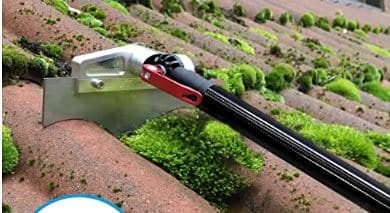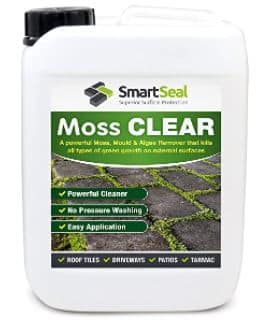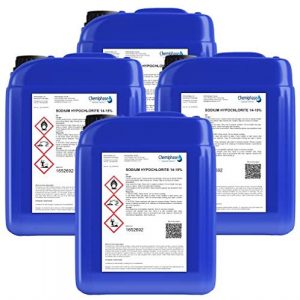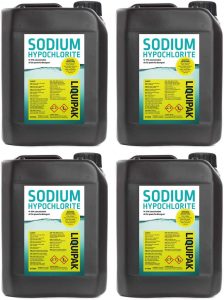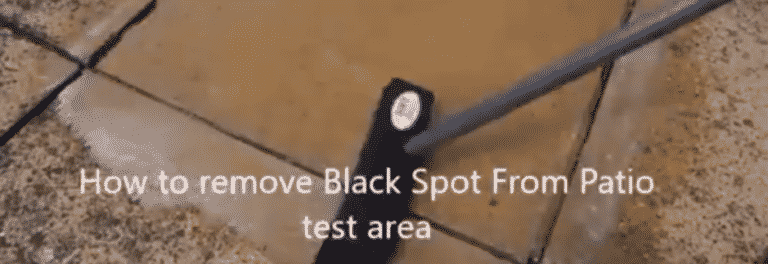How to Remove Moss From a Roof
You may have more moss on the part of your roof that faces north. Why? North facing roofs usually receive much less sunlight that the rest of your roof. Less sunlight means more moss build-up on your roof.
Seeing this green, fuzzy growth on your roof is rarely a pleasant sight. With nearly 12 million results on google for this question, it is certainly a very common problem for many in the UK. But, what is the best way to remove moss from your roof?
There are many different products and methods out there, but in this article, we will be discussing the best ones to use and where you can buy them. We also offer a moss removal service.
What is the best way to remove moss from a roof?
Moss can be unsightly and potentially damaging to a roof over time. Here are some steps to safely and effectively remove moss from a roof:
- Safety First: Before starting any work on a roof, ensure you have proper safety gear such as non-slip shoes, a harness, and a sturdy ladder.
- Prepare the area: Clear the area around the roof of any debris using an extendable scrapper and ensure that gutters and downpipes are clear of debris as well.
- Mix a cleaning solution: Mix a solution of one-part bleach to three parts water in a pump sprayer or bucket. Add a small cup of washing up liquid to help the solution adhere to the roof.
- Apply the solution: Apply the solution to the affected area of the roof using a pump sprayer or a brush. Be careful not to apply too much pressure, as this can damage the roof.
- Wait: Allow the solution to sit on the roof for about 15-20 minutes to penetrate the moss.
- Rinse: Rinse the roof thoroughly with a garden hose or pressure washer on the lowest setting. Be careful not to use too much pressure, as this can damage the roof.
- Repeat if necessary: If the moss is still present, repeat the process until it is completely gone.
- Prevent future moss growth: To prevent future moss growth, trim any overhanging branches or foliage that is casting shade on the roof. Additionally, you can install copper or zinc strips along the ridge of the roof, which will release chemicals that inhibit moss growth. Alternatively apply a good anti moss biocide.
- It is important to note that moss growth on a roof can be an indication of deeper issues, such as poor ventilation or a damaged roof. If you are unsure about the state of your roof, it is best to consult with a professional roofing contractor.
Roof Cleaning Tools and Equipment
Use these rof cleaning tools, make it easy and safe. Maybe you are already cleaning windows and gutters, you can easily add roof cleaning as a service, or maybe you can use these tools elsewhere and want to try cleaning and maintaing your roof yourself, obviously saving a lot of money
1. Use a scaffold Tower
These towers are lightweight, easy to put together and store away, they can be easily carried to the customers house. They are safe to use, look at these for sale on Amazon. Alternatively you can hire them from your local tool hire shop.
See this 7m Aluminium Scaffold Tower, click the image and see what you get for your money.
2. Roof Cleaning Scrapers and Telescopic Pole for Moss Removal From A Roof
The SkyScraper Holder and 11 Blades for differnet shaped roof tiles. A safe, effective, and quick way to efficiently remove moss from roofs. Choose the correct blade that fits the contour of your roof tile, attach it to the head of the telescopic pole and start scraping that ugly moss. A sturdy wire brush is included for the little bits left over.
See this The Skyscraper click the image and see what you get for your money. Also a telescopic roof scraper pole.
3. Sodium Hypochlorite and Biocide
So after you have safely and efficiently removed all the moss from the roof, it would be good to know that it will be a year or 2 before the moss starts to return. We use Sodium Hypochlorite to give the roof a nice new look, super clean. It will kill or the moss spores dead. Alternatively you can use an anti moss biocide to do the same, the only difference is the biocide will remove and kill any lichen infestations you may have on your roof. But it is not as quick to clean your roof in the way Sodium Hypochlorite does. Make sure you mix the solution with a soap, otherwise the solution will quickly run off the roof. You need it to stick and clean effectiveley, otherwise your roof will look streaky when you have finished.
Tip when applying either solution, dissconect your downpipes, and make sure you disspose any exess solution. See Sodium Hypochlorite below.
Click on images below to read reviews and purchase
What is sodium hypochlorite?
It is a disinfecting agent used for killing fungi, bacteria, viruses, and mycobacterium. It is completely safe to be used on roofs, though, when using it make sure to take safety measures such as using gloves and keeping it away from children, pets, and plants. It can be diluted with water when used on roofs.
Most professional roof cleaners out there today use a mixture of sodium hypochlorite when dealing with roof cleaning jobs that require a great deal of moss removal.
Although it can kill moss and algae, it cannot remove black stains such as lichen, mould, and mildew.
Below are many frequently asked questions about removing moss from your roof. For example, why does moss grow and how can you prevent it, what are some natural ways to remove moss from your roof if you don’t want to use chemicals, and when is the best time to remove the moss on your roof.
Sodium Hypochlorite 14-15% Concentrated Solution
Sodium Hypochlorite patio cleaner is the quick and easy long-term solution to cleaning and removing moss, algae, and weeds from your drive, patio, walls, fences, and brickwork. Used as a patio cleaner is known as the product to use, and is commonly found in dilution in various other versions of patio cleaners. The solution we have available is highly concentrated and will remove the need for numerous applications, one treatment will provide a clean and moss-free surface immediately. Available online would you believe!! Click here
Why do I have moss on my roof?
Moss grows quickly and can get between roof tiles. As it grows, even more, it can potentially lift up the roof tile, causing a breach in your roof. Eventually, rainwater will begin to make its way into your roof and cause water damage. This can also be a safety hazard if the tile becomes loose and falls off.
Water damage can cause a number of issues in a home including mould, mildew, and dampness. It can also rot and decay parts of your home, especially wood.
So, we would say it is best to get the moss from your roof removed sooner rather than later. The cost of removing moss roof doesn’t even compare with the cost of getting your roof repaired or replaced.
What to do if moss is growing on your roof?
There is a lot you can do. You can either choose to do it yourself. Purchasing sodium hypochlorite. Although this can be hazardous if your roof is high up and difficult to access. If that is the case, you can easily get in contact with your local roof cleaner and request a quote. Different roof cleaners use different methods. This may depend on the type of roof you have.
What kills moss naturally?
There aren’t many products out there for natural moss removal, but you can always use a home remedy instead. For example, vinegar or baking soda will do the trick.
When should I treat my roof for moss?
The best time to clean your roof is on a cloudy day. This is because applying sodium hypochlorite on a roof on a hot and sunny day will cause the treatment to evaporate and not be able to do what it is designed to do. The results will be lacking and you will have to do it again on an overcast day.
The best time to treat your roof with sodium hypochlorite is just before the moss begins to grow again in spring. Late winter/early spring is the time recommended. It’s best to kill the moss as early as possible before it grows even more
Does the moss on your roof die in winter?
Surprisingly, moss thrives in winter. A cold, damp, and dark environment are perfect for moss. However, when summer comes, it brings a hot sun that dries moss out and kills it. Dead moss on your roof will turn brown and look somewhat unattractive. No wonder requests for roof cleaning are so popular in summer.
The good news is that dead summer moss is much easier to remove than strong, healthy, alive winter moss. Though, you may expect it just to all dry up and fall off your roof on a particularly windy summer day. However, we’d recommend getting your roof cleaned professionally, either by yourself or by hiring a company. You can use sodium hypochlorite to effectively kill off any alive moss, and softwash it away. This will leave you roof sparkling, looking its best for the summer, and free from moss for a time.
How much does it cost to remove moss from your roof?
The price to get your roof professionally cleaned will depend entirely on the size of your roof. Also, accessibility, type of roof, and whether you want it cleaned and treated, or just cleaned. Average roofs will cost around £400-£700 to clean and treat.
How do you stop moss from growing on your roof?
As we have discussed, it is important to remove any moss that grows on your roof, as it can affect your roof in many ways. But, after you have removed it, is there any way to prevent it from growing back? Or, at least slow down the process? Yes. There are a number of steps you can take.
After you have cleaned your roof, or have had it professionally cleaned, you want to make sure you get it treated with an anti-moss biocide, or with sodium hypochlorite. This will not only kill existing moss, but it can prevent moss from growing in the future. Leaving this treatment on your roof will keep it clean and moss-free.
Moss spreads by releasing spores. These spores will settle well on cool, damp, dark places. So, do all you can to make your roof as dry and exposed to do sun as possible. One way you can do that is by removing overhanging tree branches.
Another step you can take in preventing moss growth on your roof is cutting back overhanging trees if possible. Trees with branches that hang above or near your roof can cause a great deal of moss to grow. They provide shade from the hot sun, and years of falling debris can cause an optimum environment for moss to thrive. Dead leaves, twigs, dirt, and other things dropped by birds can build-up on your roof. So trimming overhanging branches regularly can make all the difference in stopping moss from growing.
A big issue when it comes to moss on the roof is blocked gutters. The gutters on your roof provide an escape from water when it rains. If your roof gutters are blocked, however, water can build up and create a damp and cool environment that invites moss to grow. Make sure you check often whether your gutters are doing their job, and get them cleared out and unblocked as soon as you start seeing debris build-up.
We would not recommend using anti-moss strips as the installation process can do more damage to your roof than any moss growth. As long as you regularly maintain your roof and its surroundings, it should last a very long time.
Read next: What’s the best pressure washer to buy for home use?
Blocks of flats – Commercial gutter cleaning – Roof cleaning and moss removal – Roof Cleaning Companies – Graffiti Removal – Local Render Cleaning Service – Gutter Cleaning – Roof cleaners near me
Text or Call 07791 465052 Email admin@local-guttercleaner.co.uk
